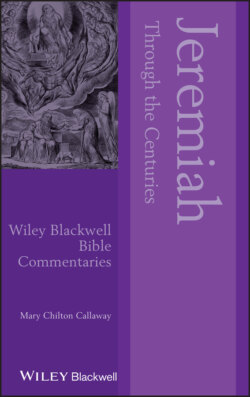Читать книгу Jeremiah Through the Centuries - Mary Chilton Callaway - Страница 13
Acknowledgments
ОглавлениеWell over a decade ago, John Sawyer entrusted me with the task of writing the Jeremiah volume for the Blackwell Bible Commentary series. His patient editorial support made it possible for me to search out the sources, sometimes translate them, and weave them into a reception history. Judith Kovacs had originally challenged me to write a proposal for the book, and with characteristic generosity offered critical and creative support throughout the writing, even though as New Testament editor of the series she did not have to read a word. Her friendship and insights have been a sustaining presence. David Gunn has given crucial help with multiple readings, corrections, and above all encouragement and advice about the pictures. Rebecca Harkin has ably steered me through the shoals.
Early in my graduate studies Professor James A. Sanders introduced me to the Hebrew text and the passionate persona of Jeremiah. Later, as my Doktorvater on another topic, he directed me to the deep theologies and holy sense of humor in Jewish exegetical traditions. His wise teaching planted the seeds for this book.
Two editors have patiently worked over every detail of the manuscript to correct my lapses. I am indebted to Cynthia Shattuck for her expert readerly eye and merciless editor’s pencil, which made the book leaner and better. Caroline McPherson put the manuscript into final shape, dealing graciously with late changes and bibliographic challenges.
Graduate students Alex Hwang and Jennifer Jamer located troves of Patristic sources and put them into a usable form, sometimes hunting down the Greek original. Ankie Wiegerink and Jan van dear Staak generously translated an eighteenth‐century Dutch text about Ebed Melek, which proved to be a challenge even for native Dutch speakers.
Fordham University has supported the project with two sabbatical leaves and a grant to help pay for permissions to publish images. Colleagues Harry Nasuti, J. Patrick Hornbeck, and Elizabeth Johnson have offered important insights and friendly goading in equal measure. Graphic designer Marc Tremitiere made many of the pictures in the book possible by expertly scanning my trove of antique prints into high‐resolution images. Marta Martin Pérez and Ariadna Fernendez at the publishing company M. Moliero generously made available high‐resolution images from the Bible moralisée, which are a linchpin in the reception history of Jeremiah.
The rich but sometimes arcane resources that provide the raw material for reception history are housed in libraries around the world. I am indebted to the patient and creative assistance given by librarians at the British Library, Bibliothèque nationale de France, Fordham University Library, Houghton Library of Harvard University, New York Public Library, Pierpont Morgan Library, and Union Theological Seminary Rare Books Collection.
I am grateful for the persistent challenge posed by members of the Writing/Reading Jeremiah Group of the Society of Biblical Literature, and the opportunities they gave me to test and refine ideas about the reception of Jeremiah. In addition, Walter Brueggemann, Robert Carroll, Andrew Mein, Kathleen O’Connor, Carolyn Sharp, and Lou Stulman have generously offered support and asked sometimes discomfiting but always generative questions. Members of the Columbia University Hebrew Bible Seminar have offered constructive critiques in a formal setting together with helpful resources informally. The nine superb essays on the reception of Jeremiah in The Book of Jeremiah: Composition, Reception, and Interpretation, edited by Jack R. Lundbom, Craig A. Evans, and Bradford A. Anderson (Brill 2018) appeared after my manuscript was substantially complete, so I was regrettably not able to incorporate their insights. Likewise, Mark Leuchter’s essay in The Oxford Handbook to the Book of Jeremiah was not available. I take these omissions as a good sign that reception history of Jeremiah has become significant in biblical studies.
Special thanks to Hannah Boone Callaway for help with translating and understanding important eighteenth‐century French texts about Jérémie, and for insights into French political history and humor. Equally valuable were her expert readerly eye and persistent challenges to make the narrative compelling.
Finally, my beloved Jamie has made this book possible. His extravagant care, creative problem solving, insightful comments, and good‐humored support are embedded in every page. He reminded me early and often that Jeremiah speaks to the present, whenever that is.
